For generations, humanity has been fascinated by the power and destructive force of atomic weapons. Tapping into this, multiple comic book publishers have featured heroes who have taken the name Captain Atom. You may know about Nathaniel Adam, the DC Comics hero who wields incredible quantum power. But what about the versions that preceded him? Let’s take a look at the history of the heroes called Captain Atom, and a few related characters, from 1948 up to 1987.
DR. RADOR AND HIS TWIN
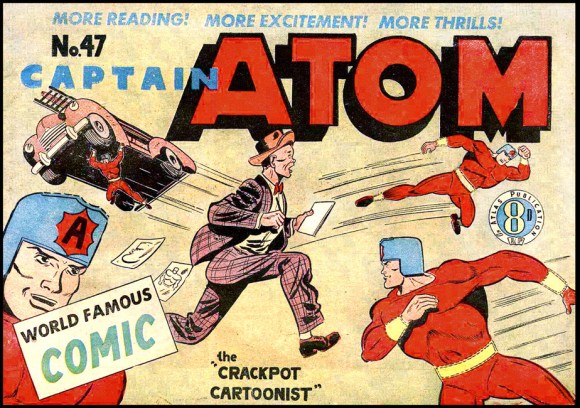
American comics had been successful imports to Australia, but then World War II happened and caused a rise in the price of paper and other materials. To save money and help the local economy, the Australian government stated enforcing the Import Licensing Regulation in July 1940, banning foreign materials in the form of paper publications or syndicated proofs. No more comics from the USA! This lead to Australian writers and artists filling in the void. In 1948, Arthur Mather created the first hero to be called Captain Atom, released by Atlas Publications (not to be confused with the American company Atlas Comics, which evolved into Marvel Comics).
The story went like this. Dr. Bikini Rador (wow, his mom named him that?) and his identical twin (whose name we never learned) were both caught in an atom bomb blast. The brothers became physically fused into one being, with Bikini being the dominant person. By shouting “Exenor!” Bikini vanished and swapped places with his now atomic-powered twin. The nameless twin adopted the alias “Captain Atom” because he was an “Atom Man” who wielded super-strength, super-speed and the ability to fly. His lungs could unleash focused air blasts and his “atomic-radar” senses perceived radio transmissions. He could also release atomic heat and force bolts from his hands.
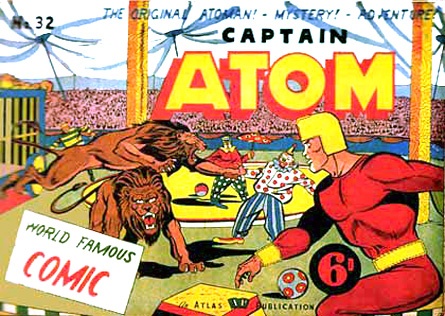
This origin may have been inspired by Captain Triumph. In 1943, publisher Quality Comics introduced identical twin brothers Michael and Lance Gallant. Michael joins the military only to be killed by a bomb. But the three Fates of Greek mythology intervene, deciding the brothers will be a force for good. Michael returns as a ghost that only Lance can see and hear. When Lance touches his T-shaped birthmark, identical to his dead brother’s birthmark, Michael’s spirit possesses his body. They become Captain Triumph, a hero of great strength, flight and invisibility. The original Captain Atom’s origin also bears a resemblance to the DC Comics character Firestorm, introduced in 1978. The hero is created when a college student and a college professor are caught in an atomic explosion which merges them into a super-powered “nuclear man.”
Back to Australia’s atomic warrior. Following being fused with his twin brother (thank you comics for making me write that), Bikini Rador started a new life as FBI agent Larry Lockhart. He investigated evil and would summon his brother into existence whenever some butt needed to be kicked. Together, the brothers fought villains such as Rigor Mort, Fireball Arson and the Frogmen of the Antarctic. His adventures were a bit odd and wacky and his costume fits in with that atmosphere. It’s almost a dull, generic jumpsuit with a big belt. But then there’s that helmet. It looks like it could belong to a military soldier, which makes sense with the hero’s name, or to a futuristic cricket player. It could be functional, but that proud monogram on it and its odd flat-top shape push it into a fun, goofy level.
But goofy or not, the stories of Australia’s atom man sold 180,000 copies regularly. The Captain Atom Fan Club boasted having up to 75,000 members. Not bad at all. So what happened to him? Well, we need to talk about what happened to the Australian comic book industry first. A few political groups and politicians targeted the medium as a bad influence on the youth. Then, the ban on imported goods was lifted, meaning American comics came back to Australia.
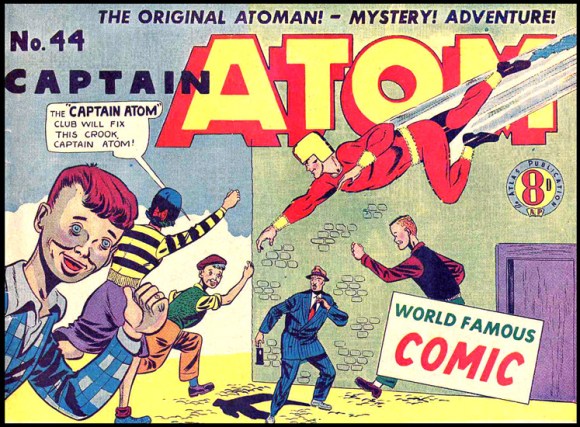
Despite this, Captain Atom’s adventures continued to be popular and outsold Superman. But in the late 1940s psychiatrist Dr. Frederic Wertham notoriously led an anti-comic book campaign in the US. In 1954, he published the book Seduction of the Innocent. After reading the book, Chief Secretary of New South Wales C.A. Kelly declared comics corrupted children with “distorted ideas of sex, sadistic lusts, and the firm conviction that crime is a paying proposition.” Many criticized Wertham’s evidence, research methods and conclusions and decades later it was discovered he had falsified some of his findings to support his ideas.
Along with the trouble caused by Wertham’s influence, the government of Victoria introduced laws to penalize any publisher whose comics were deemed “unsuitable.” 1954 also saw the Queensland Literature Board of Review ban 45 publications, with comic books making up a third of that group. Neither Victoria nor Queensland defined their standards of what made material unsuitable.
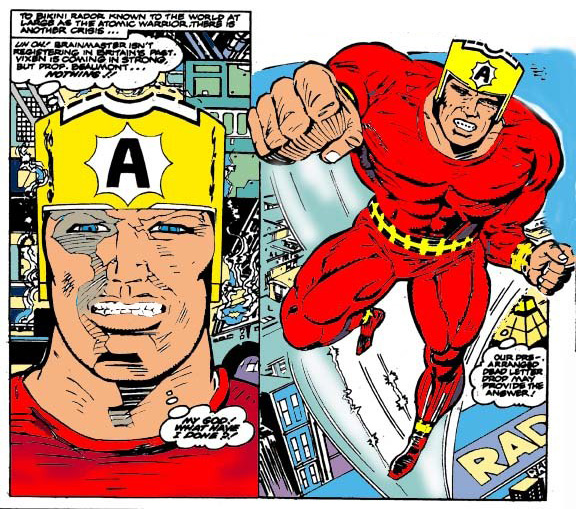
The High Court of Australia intervened, but the damage was done. Captain Atom was cancelled months after Seduction of the Innocent was released and it would be decades before Australia built up a comic book industry again. For years the National Library of Australia refused to preserve any comics, as they were not considered true literature. An altruistic collector and historian named John Ryan spent years grabbing every Australian comic he could and then donated his collection to the National Library in 1972, by which point attitudes had changed. The collection became the foundation of a now larger comic archive. Six years later, Ryan published a book entitled Panel By Panel, which included extensive research on the Golden Age comic industry of Australia and all the creators involved. It is often considered the bible of Australian comics. If not for him, we would have lost most, if not all, evidence of Captain Atom and his contemporaries. Ryan died two months after publishing his book.
The Rador version of Captain Atom appeared again briefly in the 1980s and in Vixen Magazine.
A SCIENTIST FOR THE KIDS
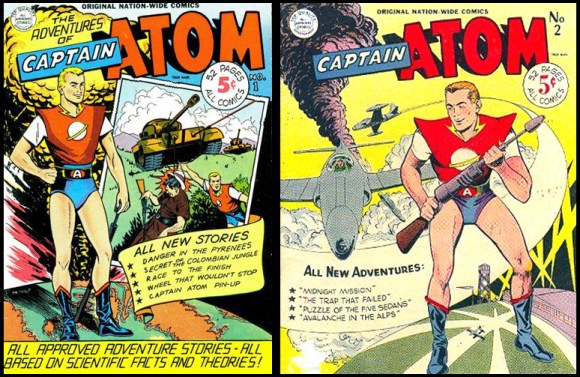
Back in the US, the American publisher Nationwide created its own hero called Captain Atom in 1951. Like Bikini Rador’s brother, we never learned his name. Was “Atom” a surname or an alias? In any case, the character wasn’t a superhero really. By this time, superheroes had fallen out of favor in US comics. This captain was a scientist-adventurer who solved mysteries around the world, following in the steps of Tom Swift and Doc Savage, with a dash of Flash Gordon. He fought strange villains and menaces with his educated know-how and technology of his own creation, such as the “spectrascrope” and a “walkie-talkie television.” He also often piloted high-tech vehicles such as his “atom submarine” and a noiseless atomic powered rocket ship.
The costume is almost a perfect summary of Golden Age sci-fi heroes. You can just imagine this guy meeting Adam Strange, Flash Gordon and David Starr, Space Ranger for drinks. Of course, that also makes the costume a little generic. It’s as if he’s the idea of a scientist adventurer but isn’t a character on his own. A monogram “A,” a lightning bolt collar, a ringed planet. None of these symbols have any real meaning for him and his origins. They’re just there to tell you he’s a science fiction character.
By the way, no one try to correct me and tell me that the Space Ranger’s name is Rick. Rick Starr, Space Ranger is a different character than his predecessor David Starr, who appeared in stories written by Isaac “My Influence Is Everywhere” Asimov.
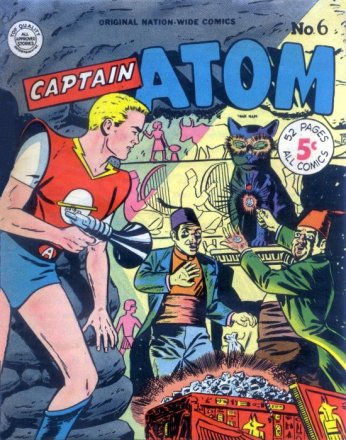
In the 1950s, there was new pressure on comics to have educational and/or moral value for children. Captain Atom’s adventures were designed to teach kids about science and boasted they were “all based on scientific facts and theories!” After each story, an epilogue summarized the science that inspired the events. Not a bad idea, actually.
This version of Captain Atom was cute but didn’t strike a strong chord with anyone. The series lasted seven issues. This Captain Atom made no other appearances aside from a one-shot entitled Captain Atom: Secret of the Columbian Jungle.
THE CHARLTON HERO
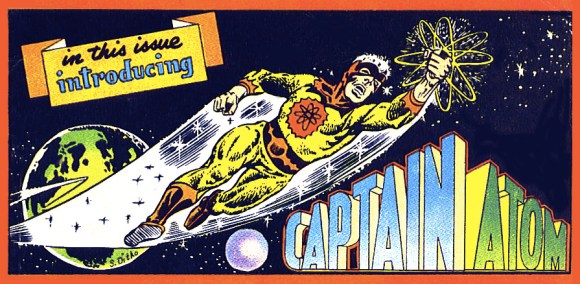
In 1956, DC Comics began the Silver Age of superheroes. By the 1960, masked adventurers were back in full force. That same year brought us a new Captain Atom, this time published by Charlton Comics. Charlton was known for its low-budget paying some of the lowest rates in the comic book industry, as well as often using unpublished material acquired from other publishers. Created by Joe Gill and Steve Ditko, the Chalton version of Captain Atom debuted in Strange Adventures #33.
This atomic hero begins life as Captain Allen Adam USAF, though a few subsequent issues accidentally refer to him as Allen Adams. We’re immediately told by a narrator that Adam is a scientific prodigy with expert skills in engineering, chemistry, physics and ballistics. According to later issues, he is the leading expert in nuclear science. The origin story opens up on a new experimental rocket named Atlas, armed with a warhead, ready to launch. Despite the fact that the countdown sequence has already started, Capt. Adam decides to go inside the rocket and make some minor adjustments. He drops his screw driver and somehow wastes a whole two minutes trying to get it again. By then it’s too late. Even though they know Adam’s aboard, the military men in charge of the Atlas launch can’t seem to shut down or delay the launch.
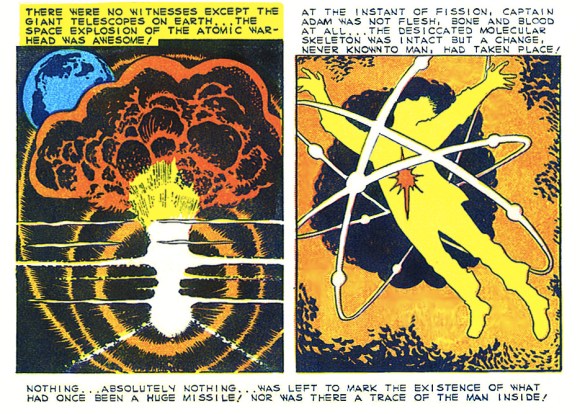
Atlas launches into space. Adam loses consciousness from the G-force and then the warhead detonates 300 miles above Earth. Adam is disintegrated, but that isn’t the end of his story. Minutes later, he materializes on Earth again. His body is now “pure U-235” making him a radioactive life form. He informs his superior General Eining to fetch the lightweight radiation-shielding metal diulustel. From this material, Adam makes a bodysuit that protects others from his radiation by converting it into another frequency in the light spectrum. Now he’s safe, but he’ll have to wear the outfit underneath his clothing at all times.
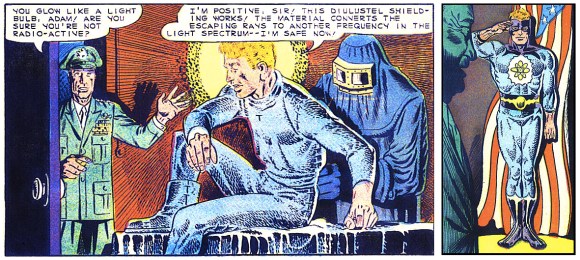
Thanks to the atomic energies charging his body, Adam can fly, release atomic force blasts, become invisible and phase through solid matter. After demonstrating his abilities, the mutated scientist is summoned to the Oval Office. The president adds a belt, chest symbol, mask and boots to the radiation suit. Now, Captain Allen Adam will also be a hero to protect America from foreign powers, alien invaders and other menaces. Codename: Captain Atom. Aside from the President and a couple of high officials, the only one who knew about Allen’s new double life was his buddy Sgt. Gunner Goslin.
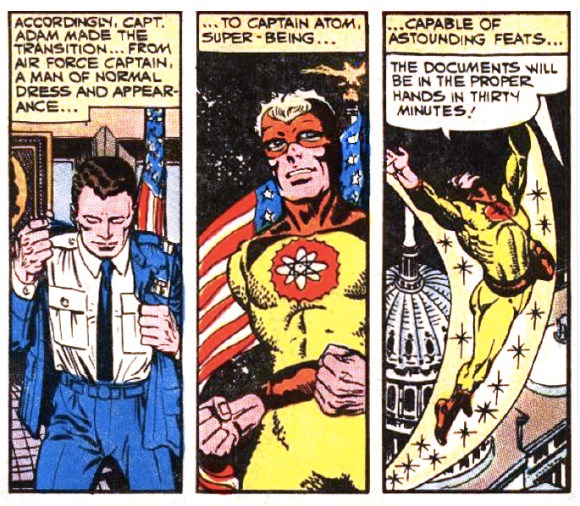
On the cover of his debut issue, Captain Atom had a yellow and orange costume. The interior story, however, gave the light-weight metal jumpsuit a blue and purple color scheme. But starting with his second adventure, Cap’s costume was indeed yellow and reddish orange. Sometimes when Captain Atom was needed, Allen would do the classic superhero act of taking off his outer clothing to reveal the costume underneath. A couple of times, he used his atomic energies to disintegrate his outer clothing instantly.
It was also established that Allen Adam had dark hair but then it became blond/white when he operated as Captain Atom. This helped keep his identity secret even when he was unmasked. Wait, really? Huh.
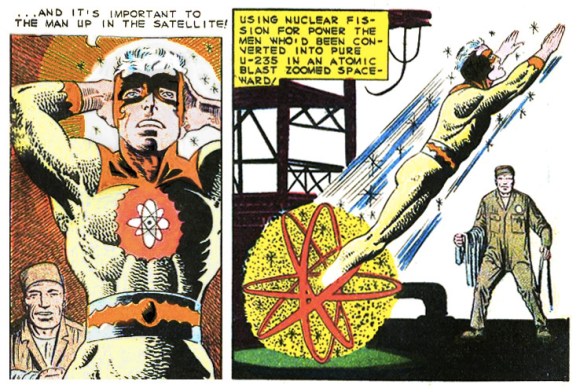
It’s not a bad jumpsuit at all and is one of the sleeker outfits of the 1960s superhero era. I’m personally not a fan of costumes being mostly yellow, but it does make sense that the brightness reflects Captain Atom’s atomic powers and that he gained them when a warhead exploded. The outfit has a chain mail look to it, which keeps the idea this is made from metal but also lets us believe it’s flexible enough for him to move around in. Chain mail also makes him seem like an atomic warrior from some kind of retro future where we rely on medieval armor again. Though I do wonder why none of Captain Allen Adam’s colleagues noticed the chain mail underneath his shirt or heard it when he moved.
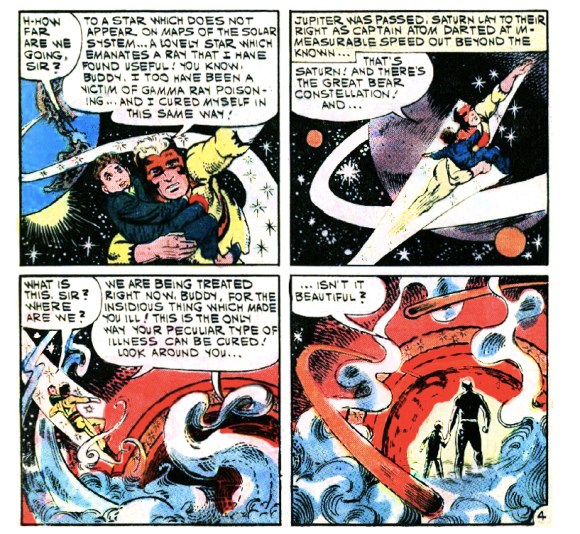
I want to quickly point out that Captain Atom’s early adventures weren’t just about US patriotism and military superiority. In his second adventure, the atomic superhero goes out of his way to rescue the life of a Russian cosmonaut trapped in a space capsule. He doesn’t try to learn any Russian secrets in the process and he also makes sure to help in a way that doesn’t make the USSR feel threatened. A couple of stories involved Captain Atom having strange, fairy tale like adventures with children. One featured a young boy dying of radiation poisoning. Captain Atom takes the boy to a planet where the atmosphere will fix his biology. The two then marvel at the strange otherworldly landscape for a few minutes before taking a brief tour of the solar system.
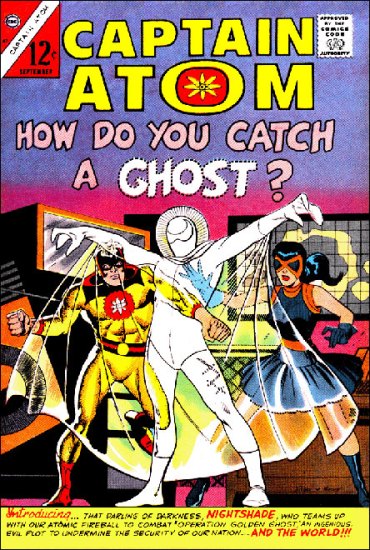
In 1966 Captain Atom met another super-powered hero on a government payroll: Eve Eden aka Nightshade, a “darling of darkness” who was described by the narrator as “one of the most attractive spy smashers that our country has ever had!” Debuting in Captain Atom #82 she was a blond stunner who dressed in a mask, black haired wig and a black outfit to fight spies and enemy agents. She had no powers at first, but was an incredible fighter. The lack of powers and darker costume put her in contrast to Captain Atom in a similar fashion as the team-ups of Batman and Superman.
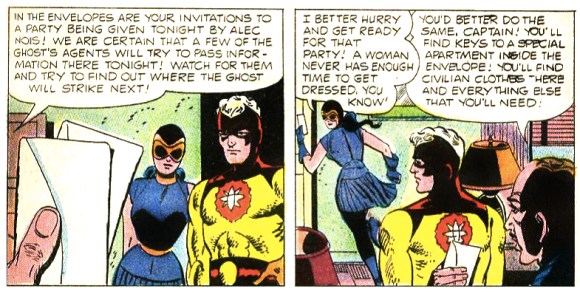
The two got along and there was a little romantic tension between them as well. They began teaming up regularly until Nightshade went on to have her own series, along with powers and a magical origin story.
ALLEN ADAM’S INVISIBLE COSTUME!
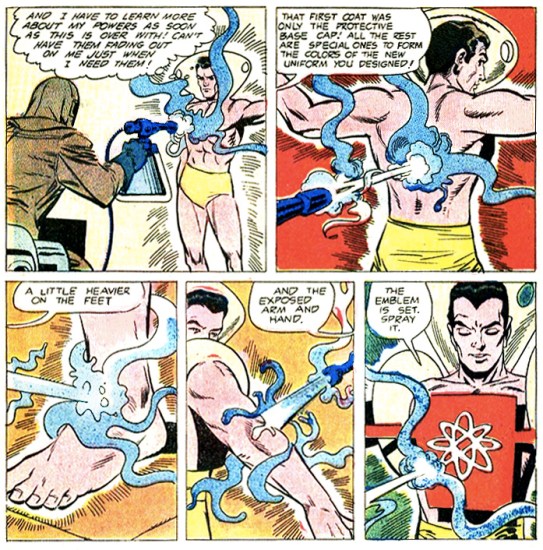
In Captain Atom #83 the hero’s costume was breached just moments before adoring fans and members of the press arrived. Panicking, he shouted at them to keep away so he didn’t poison them with radiation. This led to the media suddenly putting a lot of suspicion on Captain Atom. Was he safe to trust as a superhero? What if he made people sick? Just why did he wear a mask? Masks mean a person has something to hide! This led into Captain Atom #84 where Allen Adam used his scientific skills to create a new mask-less look.
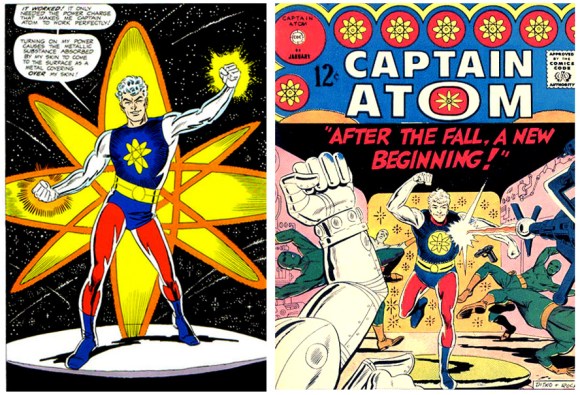
In his lab, Allen stripped down and had his body covered by a spray of special liquid metals. The particles of this liquid metal would hide beneath his skin, protecting others from his radiation at all times. When he charged up his powers, the metal shell became visible. This is a pretty fun outfit. It immediately marks Captain Atom as an idealistic, classic style of superhero. He was the Charlton Comics equivalent of Superman, with an even lazier disguise (“No one will recognize me with white hair!”). It suited him very nicely.
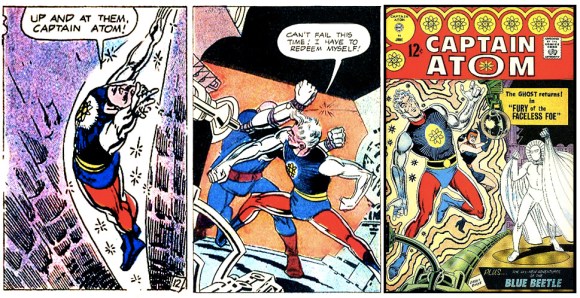
Unfortunately for the captain, this new costume and his partnership with Nightshade weren’t enough to save the character. Charlton cancelled all their superhero titles in 1967 and Captain Atom ended with issue #89. Ditko had finished drawing Captain Atom #90 but not its inking. In 1975, John Byrne finished inking the pages and they were published in the first two issues of the official Charlton Comics in-house fanzine Charlton Bullseye. Years later, Charlton Bullseye was reformatted as a comic book to showcase new talent. Allen Adam appeared in issue #7 (1982) in a flashback story which depicted him in his old yellow and red suit.
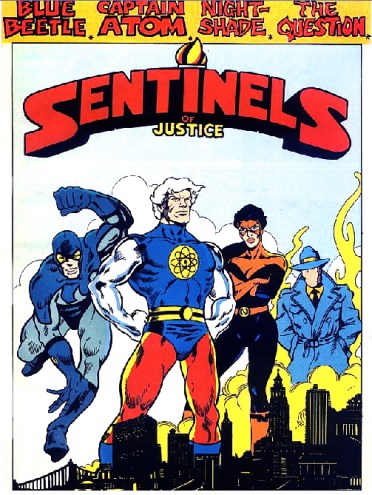
AC Comics, which specialized in reprinting stories from defunct publishers, featured several Charlton heroes in the 1983 one-shot comic Americomics Special #1. This story had Captain Atom and Nightshade partner up once again. They were joined by the vigilantes Blue Beetle II (Ted Kord) and the original Question (Vic Sage), who had also acted as on-again, off-again partners during their Charlton days. The four heroes decided to band together as a team called the Sentinels of Justice. This team was never seen again. Well…not exactly.
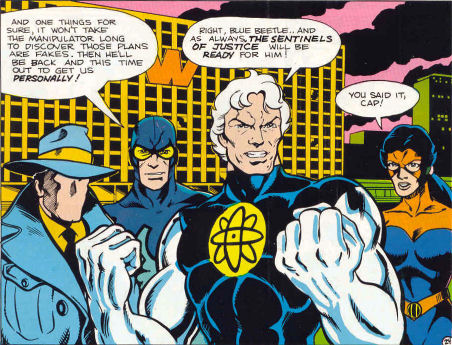
In any event, Charlton Comics stopped publishing in 1984 and DC Comics acquired the rights to its heroes. During the crossover story Crisis on Infinite Earths (1985-86), the Charlton heroes met the DC heroes for the first time. It was said the Charlton heroes’ version of Earth existed within the DC Multiverse, designated Earth-4. The Charlton version of Captain Atom then appeared in DC Comics Presents #90 where he met Firestorm, the nuclear man.
In 1986 the effects of Crisis on Infinite Earths (now sometimes called “the First Crisis”) swept across DC Comics, rebooting continuity and history across the board. Earth-4 was destroyed, but elements of it were fused into the mainstream DC Universe.
THE CAPTAIN ATOM STAND-INS
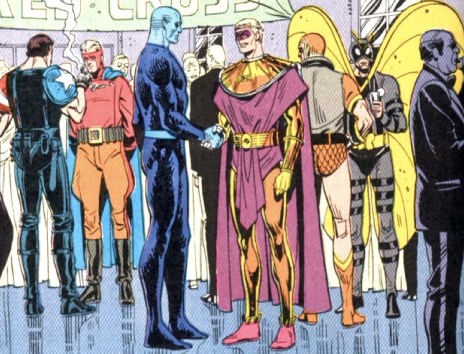
Having made a career that often involved deconstructing superheroes, writer Alan Moore now wanted to write the final story of the Charlton heroes. The idea was they had been forced to retire many years ago (hence why their comics stopped being published) but would now would gather again when one of their own, the hero Peacemaker, was found murdered. The story would explore the hidden darkness of the Charlton world and how it and its heroes had grown darker still since we last saw them. Captain Atom had lost touch his humanity and the Question was now mentally unhinged.
DC intended to integrate the Charlton heroes into the new Post-Crisis DC Universe. Moore’s story was deemed a bad idea because it would render those character unusable, serving as their last chapter. So instead, Moore changed all the characters slightly in name and origin. Artist Dave Gibbons also gave them all new appearances, but often added small similarities to their Charlton predecessors. Americomics Special had referred to four of the Charlton heroes as the Sentinels of Justice. As a reference to this title, Moore’s story was called Watchmen and the same four characters became the heroic protagonists. Nightshade became Silk Spectre, the Question became Rorschach, Blue Beetle became Nite Owl and Captain Atom became Dr. Manhattan (a reference to the Manhattan Project). The 12-part series started hitting shops in 1986.
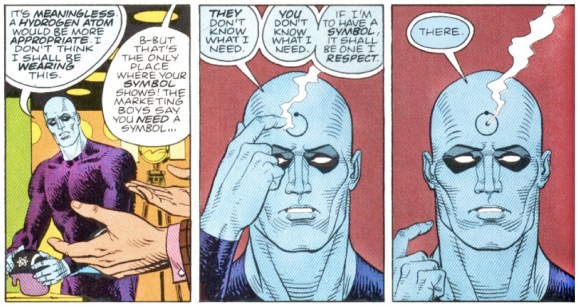
Dr. Manhattan was a scientist Dr. Jon Osterman. One day he is caught in an “intrinsic field subtractor” and is disintegrated. Then, like Allen Adam, he rematerializes in a new, super-powerful form. While Captain Atom was radioactive, Moore considered Dr. Manhattan to be a quantum being. His early adventures as an agent of the US government depict him in a chain mail bodysuit that resembles Allen Adam’s proto-suit, only purple in color. His blue skin reminds me of the blue coloring of that same proto-suit, before Allen Adam switched to his gold and red outfit. Before he begins his missions, Dr. Manhattan is also given a helmet with the classic atomic model that was Captain Atom’s symbol. But Osterman refuses to wear it the helmet and dismisses its symbol as he doesn’t respect it. He then draws a hydrogen atom onto his forehead, believing it to be more appropriate to his nature.
Due to the success of Watchmen, and the movie adaptation that occurred in recent years, Dr. Manhattan has overshadowed the character he was based on. The general public now recognizes Dr. Manhattan more readily than any incarnation of Captain Atom (though being a giant often-naked blue guy certainly helps to make yourself memorable). It’s a bit of a shame, considering how interesting Allen Adam (and his later incarnation Nathaniel Adam) is.
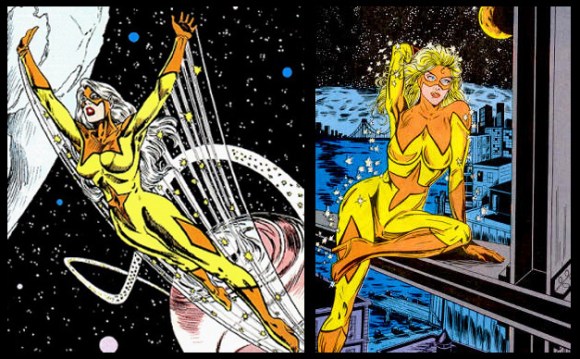
In the meantime, Americomics continued the Sentinels of Justice team. With all of the previous members no longer available, writer/editor Bill Black created new characters to fill in similar roles. Captain Atom’s replacement was female hero Mara aka Stardust. She was said to be the top scientist of female-dominated planet called Rur. When her planet was conquered, Dr. Mara went to Earth in order to recruit a superhero named Captain Paragon. When that didn’t work out, she used her “Stellar Erg Implementer” to empower her body with stellar radiation. Suiting up in a special radiation suit to prevent her presence from harming those around her, she became the hero Stardust. So like Captain Atom, she had incredible raw power and was an expert in several scientific fields.
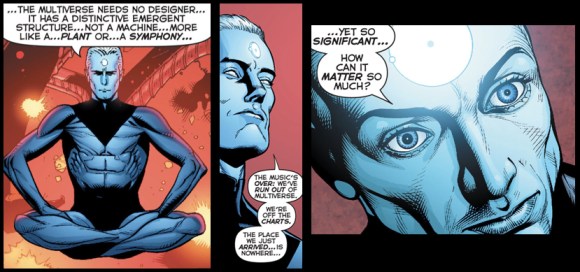
One last note, since we were speaking of Dr. Manhattan a little bit ago. In 2008 DC Comics published Final Crisis, a crossover written by Grant Morrison. In Morrison’s two-part tie-in story Final Crisis: Superman Beyond the Man of Steel teamed up with champions of parallel Earths who were, like him, arguably the most powerful protectors of humanity. One of these alternates was Captain Allen Adam, an inhabitant of a new version of Earth-4 which had recently come into existence. This man didn’t have a superhero alias, but he was known on his planet as a “quantum superman.” In his parallel universe, physics worked a little differently and this helped make him such a powerful being.

Morrison’s Captain Adam was an obvious nod to Captain Atom’s Pre-Crisis roots that incorporated elements of Dr. Manhattan. He sported the familiar blue skin, forehead tattoo and strange way of speaking we’d seen in Watchmen. His only clothing was a simple navy blue bodysuit. His hydrogen tattoo was on its side rather than exactly matching Jon Osterman’s symbol and it would often glowed. While Moore’s Dr. Manhattan had eventually lost touch with humanity due to his heightened senses and perception of time, Morrison’s new Captain Adam of Earth-4 used drugs to dull his senses to more acceptable levels. Captain Adam will be appearing again in Morrison’s upcoming project Multiversity. Personally, I’m very excited for it.
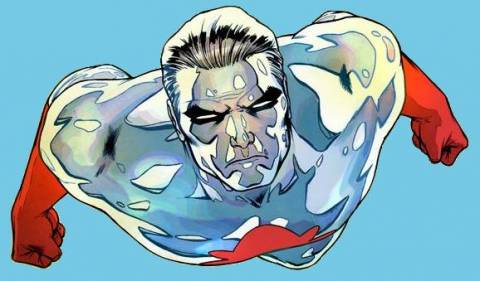
Enough with the stand-ins. In 1987 DC Comics introduced the official Post-Crisis version of Captain Atom, whose real name was Nathaniel Adam. We’ll speak of him and his career in PART 2! Hope you enjoyed this. Be sure to send us suggestions for other characters you’d like us to tackle in Agent of S.T.Y.L.E.
Alan Sizzler Kistler (@SizzlerKistler) is an actor and writer who moonlights as a geek consultant and comic book historian. He chose Captain Atom as a column focus because Greg Weisman asked him to and because he has a longstanding fondness for Allen/Nathaniel Adam. He is the author of Doctor Who: A History.
Are you following The Mary Sue on Twitter, Facebook, Tumblr, Pinterest, & Google +?



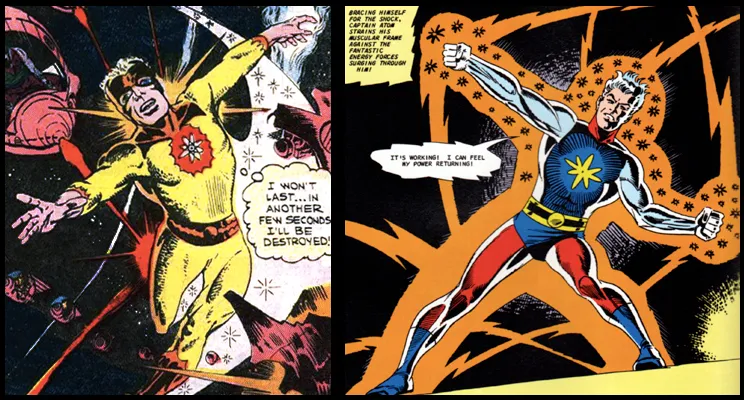





Published: May 29, 2014 02:45 pm